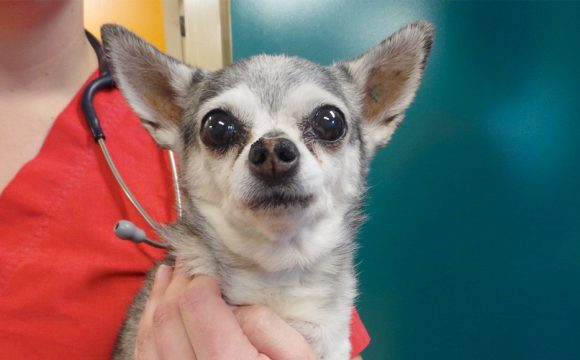Nomen est omen: The name “wobbler syndrome” is derived from the English word “to wobble” for “wobble” or “unsteady walking”. Strange gait or paralysis are typical of wobbler syndrome. This is not a disease in its own right, but rather related symptoms. You can read all information about wobbler syndrome here.
Wobblers Disease in Dogs
- The cause is damage to the cervical area of the spinal cord;
- First description in 1967 on a Basset Hound;
- More common in large and male dogs;
- Affected breeds include: Bernese Mountain Dog, Dachshund, Doberman, Great Dane, Irish Wolfhound, Labrador Retriever, Poodle, Giant Schnauzer, Weimaraner;
- In humans, the complex of symptoms is known as cervical spinal stenosis;
- Experts also call the “wobbler syndrome” in dogs “cervical spondylomyelopathy”.
Causes of Wobbler Syndrome

The two most common causes of wobbler syndrome in dogs are congenital malformations and diseases of the intervertebral discs due to wear and tear.
In rare cases, tumors or abscesses can be the cause of wobbler syndrome. In very large dogs, too much calcium, especially in the growth phase, can promote wobbler syndrome. Because if XL breeds like Great Danes grow too quickly in their youth, this leads to skeletal malformations. Owners of large breed puppies should take this into account through appropriate diet and exercise.
Symptoms: Recognize Wobbler Syndrome
In the case of wobbler syndrome, dog owners primarily notice a different gait pattern for their dogs. Affected dogs walk unsteadily and unsteadily. Experts speak of the occurrence of an “ataxia”, an uncoordinated movement sequence. The gait disorders usually develop insidiously, which makes them noticeable late.
Characteristic is a dragging, expansive gait of the hind legs.
The front legs tend to take smaller steps. “Latschen” at the back, “tapping” at the front – the gait pattern doesn’t match. Some dogs drag their claws across the ground or stand with their legs wider than they used to be. Later on, there are problems getting up. Some dogs have neck pain. You move your neckless or keep your head down. Complete paralysis of the legs rarely occurs suddenly.
Symptoms are not always clear and can suggest other vertebral disorders. An accurate diagnosis requires a veterinarian.
Diagnosis at the Veterinarian
Anyone who observes gait abnormalities in their four-legged friends should take them to a veterinarian. The vet will give the dog a thorough examination, checking reactions and reflexes. In the case of wobbler syndrome, an X-ray is one of the most important diagnostic options.
Most dogs require a short anesthetic for this. Because in addition to the optimal storage for the exposure, a contrast medium helps to find out the cause of the wobbler syndrome. In rare cases, the vet will recommend CT or MRI scans for a more accurate diagnosis.
Therapy for Wobbler Syndrome
The Wobbler syndrome is treated “conservatively” or by means of an operation. Pain medication and physiotherapy complement both methods.
Conservative Therapy
“Conservative therapy” means first and foremost: wait and see. Unfortunately, this is to be understood literally for the dog. Because the four-legged friend should move as little as possible. Walks should be kept short and the dog must be kept on a leash. A chest harness relieves the neck. Jumps and stairs are prohibited.
In addition, the four-legged friend can receive painkillers. Conservative therapy is suitable for mild courses and requires patience and discipline.
Surgery on the Cervical Spine
Surgical intervention in the cervical spine is best done in a specialized veterinary clinic. Depending on the procedure, the operating veterinarian is concerned with stabilizing the cervical spine or relieving the pressure on it.
In the case of a herniated disc, for example, the doctor mills a hole in the vertebral body through the underside of the disc and removes the herniated disc material. Veterinarians refer to this procedure as the “ventral slot”. Another option is to remove the vertebral arch. This relieves the pressure in the upper area of the vertebrae.
Some of the frequently affected Doberman dogs suffer from a coagulation disorder, the Von Willebrand factor deficiency. They have an increased risk of life-threatening bleeding during an operation on the cervical spine.
Such an operation can require a stay of several days at the veterinary clinic. The attending veterinarian will prepare a cost estimate beforehand. Because an operation on the cervical vertebra can cost $3,500 or more.
Physiotherapy for Wobbler Syndrome
Whether conservative therapy or surgery: a visit to the physiotherapist makes sense with a “wobbler dog”. For example, the physiotherapist can show you massage techniques that are good for your four-legged friend. After an operation, it helps to strengthen the muscles and support healing. Physiotherapy can reduce the risk of relapse.
What is the Prognosis for Wobbler Syndrome?
The prognosis for wobbler syndrome depends on the cause. A narrowing of the spinal cord can also be associated with an unfavorable prognosis in a young dog. The prognosis must always be made individually.
Especially in Great Danes, malformations of the vertebral arch or articular processes can occur, which are associated with a good prognosis. “Watch glass compression” can also often occur in the same breed. With her, the pressure is on all sides of the vertebrae. This speaks for a lower chance of the dog being free of symptoms.
If there is a herniated disc in older animals that are otherwise in good health, the prognosis tends to be good. However, the owners should adjust diet and exercise if necessary to prevent further disc problems.

